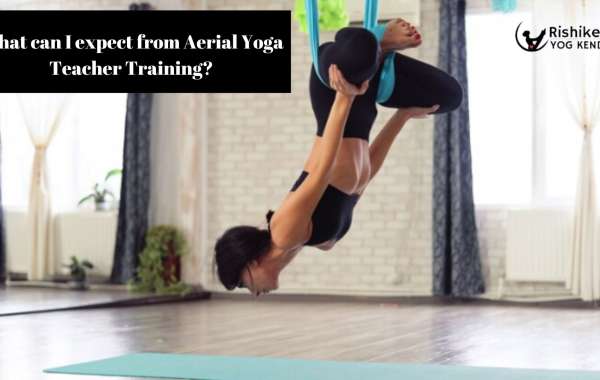Aerial yoga, also known as anti-gravity yoga, is a unique form of yoga that combines traditional yoga poses with the use of a suspended hammock. This innovative practice allows practitioners to explore new dimensions of movement and experience the benefits of yoga in a completely different way. For those interested in becoming certified instructors, Aerial Yoga Teacher Training offers a comprehensive and enriching experience. In this blog post, we'll explore what you can expect from such a training program, covering key aspects such as curriculum, benefits, challenges, and the overall experience.
1. Comprehensive Curriculum
Aerial Yoga Teacher Training programs are designed to equip participants with the knowledge and skills needed to teach aerial yoga safely and effectively. The curriculum typically includes:
Fundamentals of Aerial Yoga: Understanding the basics of aerial yoga, including the use of the hammock, foundational poses, and safety guidelines.
Anatomy and Physiology: A deep dive into the anatomy relevant to aerial yoga, focusing on muscle engagement, joint safety, and injury prevention.
Sequencing and Class Structure: Learning how to design and sequence classes, including warm-ups, flows, and cool-downs. Instructors will also be trained to cater to different skill levels and body types.
Teaching Techniques: Techniques for cueing, demonstrating, and assisting students in aerial yoga poses. This includes learning how to provide modifications and adjustments for various abilities.
Philosophy and Mindfulness: An exploration of the philosophical aspects of yoga and the incorporation of mindfulness practices into aerial yoga sessions.
Business and Ethics: Insights into the business side of teaching, including marketing, class management, and ethical considerations.
2. Physical and Mental Benefits
Aerial Yoga Teacher Training not only equips you with teaching skills but also offers numerous physical and mental benefits. The physical aspect includes:
Increased Flexibility and Strength: The hammock allows for deeper stretches and helps in building core strength and upper body muscles.
Improved Balance and Coordination: Practicing poses in the air challenges your balance and enhances body coordination.
Spinal Decompression: Hanging upside down can relieve pressure on the spine and alleviate back pain.
Mentally, aerial yoga can:
Reduce Stress and Anxiety: The sensation of floating and the practice of mindfulness can help in reducing stress and promoting relaxation.
Boost Confidence: Mastering aerial poses can build confidence and a sense of accomplishment.
3. Challenges and Overcoming Them
While Aerial Yoga Teacher Training is a rewarding experience, it does come with its challenges. Some common challenges include:
Physical Demands: Aerial yoga can be physically demanding, especially for beginners. Building the necessary strength and flexibility requires consistent practice.
Fear of Inversion: Some students may have a fear of going upside down or being suspended in the air. Overcoming this fear is a significant part of the training.
Learning Curve: Mastering the use of the hammock and learning to instruct others can be challenging. However, with practice and patience, these skills can be developed.
To overcome these challenges, it's essential to maintain a positive attitude, stay consistent with practice, and seek support from instructors and fellow trainees.
4. Supportive Community and Networking Opportunities
One of the most enriching aspects of Aerial Yoga Teacher Training is the sense of community it fosters. Participants often form close bonds with fellow trainees, sharing experiences, challenges, and triumphs. This supportive environment provides a space for personal growth and encourages open communication. Additionally, networking opportunities with experienced instructors and industry professionals can open doors to teaching positions and collaborations in the future.
5. Practical Teaching Experience
Aerial Yoga Teacher Training programs often include practical teaching components. Trainees may have the opportunity to lead practice classes, receive feedback, and refine their teaching skills. This hands-on experience is invaluable, as it builds confidence and prepares trainees for real-world teaching scenarios.
6. Certification and Career Opportunities
Upon successful completion of the training program, participants receive a certification that qualifies them to teach aerial yoga. This certification is often recognized by yoga studios and fitness centers, enhancing employability. Certified aerial yoga instructors can explore various career opportunities, such as teaching in studios, gyms, wellness centers, or even starting their own classes.
7. Personal Transformation and Growth
Beyond the technical and professional aspects, Aerial Yoga Teacher Training often leads to profound personal transformation. The journey of learning, overcoming challenges, and connecting with others can be a deeply fulfilling experience. Many trainees report a heightened sense of self-awareness, improved emotional well-being, and a greater appreciation for the mind-body connection.
Also Read: What Are the Requirements for Aerial Yoga Teacher Training?
Conclusion
Aerial Yoga Teacher Training offers a unique and transformative journey, blending physical practice with mental and emotional growth. Whether you're an experienced yogi looking to expand your teaching repertoire or a beginner eager to explore the world of aerial yoga, this training provides a comprehensive foundation. From mastering the use of the hammock to understanding the principles of safe instruction, the program equips you with the skills and knowledge to become a confident and competent aerial yoga instructor. As you embark on this journey, you'll not only gain a valuable certification but also experience personal growth and the joy of sharing the art of aerial yoga with others.




